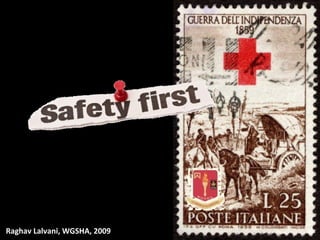
First Aid in Hospitality Industry
- 1. Raghav Lalvani, WGSHA, 2009
- 2. First aid is the provision of initial care for an illness or injury . It is usually performed by a lay person to a sick or injured casualty until definitive medical treatment can be accessed. Certain self-limiting illnesses or minor injuries may not require further medical care past the first aid intervention. It generally consists of a series of simple and, in some cases, potentially life-saving techniques that an individual can be trained to perform with minimal equipment.
- 5. In the case of Simple Slips, Trips or Falls the aim is to reduce swelling and seek medical help if necessary. It's recommended that we follow the RICE procedure if you think the casualty has a sprain or strain. First Aid Sit the person down or get them to lie down if it's easier. Apply a cold compress for 10 minutes, reassess the injury, then reapply. If after 30 minutes the swelling has started to go down, advise the casualty to rest the affected limb. If the swelling doesn't go down, it could be a break and you should seek medical advice. R……..REST I……...ICE C…….COMPRESS E……..ELEVATE
- 6. In the case of suspected complex Slips, Trips or Falls the aim is to make the patient as comfortable as possible and seek immediate medical help . Emergency Actions : Dial Emergency Services for an ambulance. First Aid Give lots of comfort and reassurance and persuade the injured person to stay still. Do not move them unless you have to. Support the injured limb with your hands to stop any movement. If there is bleeding, place a clean pad over the wound and apply pressure to control the flow of blood then bandage around the wound. If you suspect a broken leg or hand, steady and support the injured limb in the position it is in but if the ambulance is delayed you will need to put padding between the knees and ankles or under the arm and elbow.
- 7. First Aid contd…. Form a splint (to immobilise the leg further) by gently, but firmly, bandaging the good leg to the bad one at the knees and ankles, then above and below the injury. If an arm is broken, improvise a sling to support it close to the body. If you suspect a fractured foot and it doesn't distress the person too much, raise and support the injured limb. Don't give the person anything to eat or drink in case an operation is necessary. Watch out for signs of shock.
- 8. For Treatment of Severe Burns and Scalds Caution DO NOT remove anything sticking to the burn; this may cause further damage and cause infection. DO NOT touch or interfere with the injured area. DO NOT burst blisters. DO NOT apply lotions, ointment, or fat to the injury.
- 9. First Aid Lay the casualty down, protecting the burned area from contact with the ground, if possible. Douse the burn with copious amounts of cold liquid. Thorough cooling may take 10 minutes or more, but this must not delay the casualty’s transmission to hospital. While cooling the burns, check airway, breathing, and pulse, and be prepared to resuscitate.
- 10. First Aid contd….. Gently remove any rings, watches, belts, shoes, or smouldering clothing from the injured area, before it starts to swell. Carefully remove burned clothing unless it is sticking to the burn. Cover the injury with a sterile burns sheet or other suitable non-fluffy material, to protect from infection. A clean plastic bag or kitchen film may be used. Burns to the face should be cooled with water, not covered. Ensure that the emergency service is on its way. While waiting, treat the casualty for shock. Monitor and record breathing and pulse, and resuscitate, if necessary.
- 11. For Treatment of cuts and wounds – Superficial and Deep Minor Cuts and wounds usually don't require a trip to the emergency room. Yet proper care is essential to avoid infection or other complications. First Aid Stop the bleeding. Minor cuts and scrapes usually stop bleeding on their own. If they don't, apply gentle pressure with a clean cloth or bandage. Hold the pressure continuously for 20 to 30 minutes. Don't keep checking to see if the bleeding has stopped because this may damage or dislodge the fresh clot that's forming and cause bleeding to resume.
- 12. First Aid contd…. If the blood spurts or continues to flow after continuous pressure, seek medical assistance. Clean the wound. Rinse out the wound with clear water. Soap can irritate the wound, so try to keep it out of the actual wound. Thorough wound cleaning reduces the risk of infection and tetanus. If dirt or debris remains in the wound after washing, use tweezers cleaned with alcohol to remove the particles. If debris remains embedded in the wound after cleaning, let the doctor handle it. If available, use hydrogen peroxide, iodine or an iodine-containing cleanser instead of soap and water.
- 13. For Treatment of cuts and wounds Apply an antibiotic. After you clean the wound, apply a thin layer of an antibiotic cream or ointment such as Neosporin or Polysporin to help keep the surface moist. Cover the wound. Bandages can help keep the wound clean and keep harmful bacteria out. After the wound has healed enough to make infection unlikely, exposure to the air will speed wound healing.
- 14. Prevention is Better than Cure !! Thank You!!
